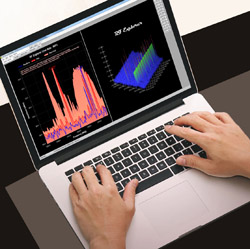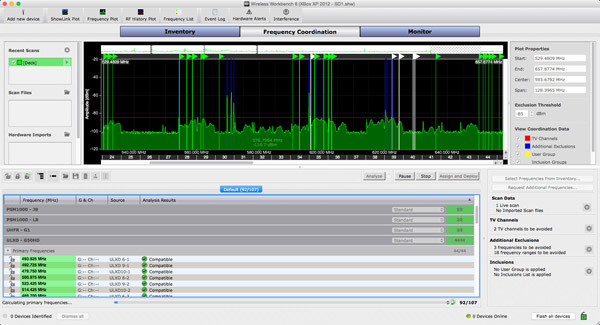
RF Explorer comes in many versions, including some that also account for Wi-Fi frequencies, handy if you’re using wireless operating in the 2.4 GHz bands. While the screen on the unit is very informative, the scanner really shines when interfaced with a computer running data acquisition and analysis software.
We employ two different software packages that basically do the same thing: RF Explorer Client for Windows and Touchstone. Both offer a large frequency spectrum display and a waterfall display (if that’s desired). Using either, we can log data and/or check out what’s happening in real time.
After seeing what’s going on in the wireless spectrum, it’s time to coordinate frequencies. Most of the time we utilize Intermodulation Analysis System (IAS) from Professional Wireless Systems. The pro version is a bit costly but allows an unlimited number of coordinated frequencies. (The basic version is limited to 30 coordinated frequencies.) In addition, the pro version provides both pre-built wireless models and the ability to create user-defined models.
Another excellent (and free) program is Shure Wireless Workbench, which works in concert with many of the company’s wireless systems, including Axient, ULX-D, QLX-D, UHF-R, and PSM 1000 personal monitor systems. It provides management and monitoring of connected wireless systems, and it can also coordinate frequencies for non-connected systems from both Shure and others. We also utilize free Sennheiser SIFM intermodulation calculation software, and it too works quite well.
Typical & Valuable
Other applications of our computers aren’t specifically audio related but nonetheless handy at shows. Most frequently used is Microsoft Office, specifically Word and PowerPoint, the latter having “saved the day” after a client’s computer with a key PowerPoint presentation has gone south. Word is convenient for typing up show notes, making signs, and of course, writing articles for this publication during down times.

Yet another computer aspect has also helped/saved clients at a number of shows: a video/media player. We keep several on our computers, and I gravitate toward VLC media player (www.videolan.org). It’s a free, open-source, cross-platform format that plays most multimedia files as well as DVDs, audio CDs, VCDs, and various streaming protocols.
Finally, our computers provide web access. Being able to download songs, check equipment manuals, download firmware updates and check email might seem mundane, but it’s important nonetheless. Plus we can quickly check our upcoming business calendar, schedule the next show, and invoice clients (literally) right after the gig. And that’s somewhat the point, right?
Senior contributing editor Craig Leerman is the owner of Tech Works, a production company based in Las Vegas.
